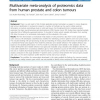BMCBI
2007
14 years 17 days ago
2007
Background: Techniques for measuring protein abundance are rapidly advancing and we are now in a situation where we anticipate many protein abundance data sets will be available i...
BMCBI
2007
14 years 17 days ago
2007
Background: In an epitope-based vaccine setting, the use of conserved epitopes would be expected to provide broader protection across multiple strains, or even species, than epito...
BMCBI
2007
14 years 17 days ago
2007
Background: Many algorithms exist for protein structural alignment, based on internal protein coordinates or on explicit superposition of the structures. These methods are usually...
BMCBI
2008
14 years 17 days ago
2008
Background: Post translational modifications (PTMs) occur in the vast majority of proteins and are essential for function. Prediction of the sequence location of PTMs enhances the...
BMCBI
2010
14 years 17 days ago
2010
Background: There is a vast need to find clinically applicable protein biomarkers as support in cancer diagnosis and tumour classification. In proteomics research, a number of met...
BMCBI
2007
14 years 17 days ago
2007
Background: The mechanisms underlying protein function and associated conformational change are dominated by a series of local entropy fluctuations affecting the global structure ...
BMCBI
2010
14 years 17 days ago
2010
Background: Thermophilic proteins sustain themselves and function at higher temperatures. Despite their structural and functional similarities with their mesophilic homologues, th...
BMCBI
2010
14 years 17 days ago
2010
Background: Protein sorting is the process that newly synthesized proteins are transported to their target locations within or outside of the cell. This process is precisely regul...
BMCBI
2010
14 years 17 days ago
2010
Background: One important goal of structural bioinformatics is to recognize and predict the interactions between protein binding sites and RNA. Recently, a comprehensive analysis ...
BMCBI
2010
14 years 17 days ago
2010
Background: Protein folding rate is an important property of a protein. Predicting protein folding rate is useful for understanding protein folding process and guiding protein des...





